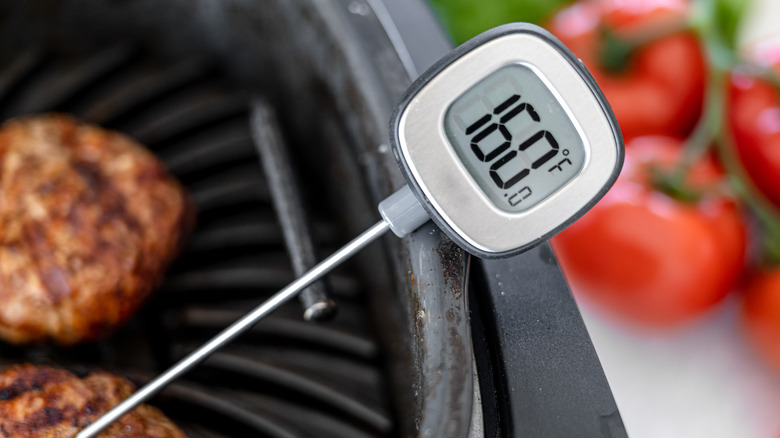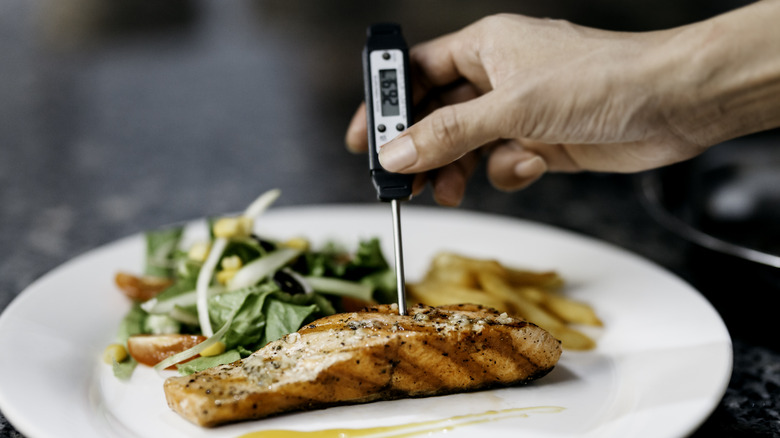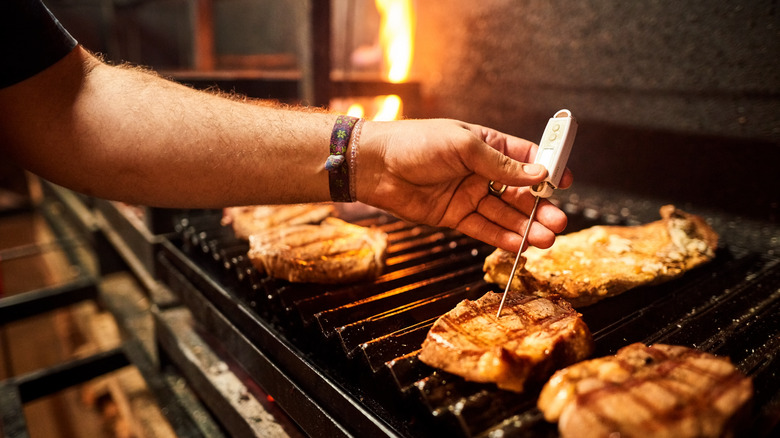How To Properly Clean A Meat Thermometer And Eliminate Bacteria
When it comes to trying to get your meat perfectly tender without overcooking it, meat thermometers are a useful tool. They're especially handy for poultry and pork, which must be cooked to 165 and 145 degrees Fahrenheit, respectively, according to the FDA. Since your thermometer is coming in contact with raw meat, you want to ensure that you properly clean it to kill any potential bacteria on it, as advised by Therm Pro.
Fortunately, cleaning a meat thermometer is a fairly easy process that should be easier than washing dishes or scrubbing the grease out of that pan. Meat thermometers aren't fussy in that regard. According to the USDA, all you need is some soap and hot water to clean your thermometer properly. Give it a good scrubbing to remove any residue from that chicken or raw beef. However, you should avoid submerging your thermometer in the water as depending on the type of thermometer you have, it could potentially damage it.
So why does soap and a good scrubbing work? Well, according to Business Insider, cleaning dishes with soap doesn't kill bacteria, so much as washes it down the drain. The soap loosens bacteria's hold to the surface of the thermometer, allowing the water to wash it away. You could also buy antibacterial soap, but there are a few other ways to ensure your thermometer has been properly sanitized.
Why you should always clean your thermometer
After giving your thermometer a rinsing, consider using rubbing alcohol to kill any remaining bacteria that may be left behind. You should use an isopropyl alcohol of 60 to 70%. Sanitizing with rubbing alcohol may be one of the easiest methods for peace of mind. All you have to do is pour some on a cloth or cotton swab and gently apply it to the end of your thermometer that touched the meat.
Alternatively, you could use cleaning products that contain bleach. Similar to alcohol, this will sanitize the thermometer and kill bacteria. You should rinse with water and soap afterward before using the thermometer again. If you don't have any rubbing alcohol or bleach, then boiling water will also work to help sanitize your cooking tool. You want to ensure that the temperature is above 212 degrees Fahrenheit, according to the New York State Department of Health.
Luckily, you have a thermometer on hand. Be careful to just submerge the tip of the instrument as boiling water can ruin your thermometer otherwise. You will also want to be careful not to accidentally burn yourself, as you'll have to put your hands close to the scalding liquid for several minutes, cautions the Phoenix Society For Burn Survivors.
Avoiding cross contamination
This may go without saying, but you will want to clean your thermometer after every use to avoid cross-contamination. This includes not using the thermometer between multiple cuts of meat before giving it a wash. As mentioned above, poultry needs to have a higher internal temperature than ground beef or pork, according to the FDA. The last thing you want to do is transfer bacteria from your chicken to your beef or vice versa during your next cookout.
For the same reason, you should avoid checking the temperature of your meat multiple times without cleaning your thermometer between uses. According to the Ministry for Primary Industries, utensils that touch raw meat should never touch cooked meat due to the risk of cross-contamination. FDA encourages a rule of cleaning and separation, keeping raw meat cooking tools away from other items in the kitchen.
According to Centers for Disease Control and Prevention, salmonella and E.coli are two potentially dangerous bacteria found in raw meat that can make someone ill. So, when handling your thermometer in the kitchen, just remember to practice proper cleanliness. Cleaning a thermometer is both quick and simple.


